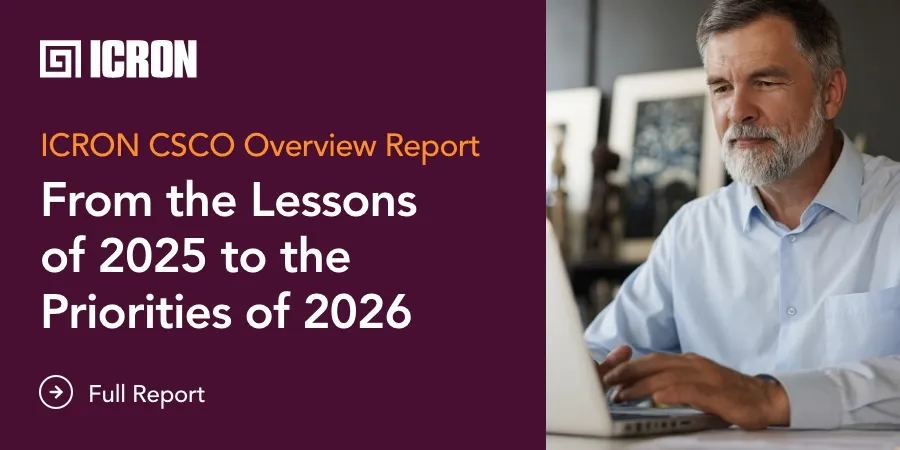
Order promising helps businesses set realistic delivery commitments that keep customers satisfied. Effective order promising is also a huge indicator of overall supply chain efficiency.
In this article, we’ll look at all there is to know about order promising, including its definition, key objectives, benefits and associated challenges, how you can create an order promising process – and how ICRON can streamline the process.
What is Order Promising?
Order promising means committing to delivery dates based on available inventory, production capacity, and supply chain constraints. It helps businesses strike a healthy balance when fulfilling orders, so they don’t overpromise or underdeliver.
Key Objectives of Effective Order Promising
Supply chain order promising helps businesses commit to customer orders with accuracy and reliability. Its key objectives will lead to a more efficient supply chain
Developing and implementing order promising strategies will help your organization improve:
- Inventory optimization. Balancing stock levels to avoid overstocking or shortage
- Production efficiency. Aligning order commitments with available capacity and resources
- Supply chain coordination. Ensuring suppliers and warehouses are in sync to fulfill orders
- Risk mitigation. Reducing or eliminating delays and disruptions by accounting for uncertainties in demand and supply
- Seamless integration. Working smoothly with inventory, production processes and platforms
How to Create an Order Promising Process
To create an order promising process, companies often use Available-to-Promise (ATP) and Capable-to-Promise (CTP) strategies. In this section, we’ll break down both, providing you with a clear idea on how they integrate with your supply chain.
Available-to-Promise (ATP) and Capable-to-Promise (CTP) strategies
Available-to-Promise (ATP) and Capable-to-Promise (CTP) are two common methods for determining accurate delivery dates. Both strategies aim to provide accurate order commitments, but differ in how they calculate availability.
Available-to-Promise (ATP)
ATP is a basic order promising method that determines delivery dates based on current inventory and incoming stock. It helps organizations be sure that orders are only promised if the required quantity is available or expected to arrive within a specific timeframe.
ATP does not consider production capacity, so it is best suited for businesses with stable supply chains and readily available stock. For example, a retailer selling finished goods in a warehouse can use ATP to confirm deliveries based on stock levels.
Capable-to-Promise (CTP)
CTP extends ATP by incorporating production and procurement capabilities. It calculates delivery feasibility by assessing available materials, manufacturing capacity, and supply chain constraints.
CTP is essential for companies that manufacture products on demand or deal with variable supply conditions. An example here would be a manufacturer using CTP to promise a delivery date by considering both current inventory and the time required to produce new units, should that be necessary.
Integration with Supply Chain Components
Supply chain order promising connects directly with inventory, production, and distribution. For maximum efficiency, each component of the supply chain must work together to avoid delays and keep promises realistic.
- Inventory management. Order promising checks stock levels before confirming an order. If an item is available, you can immediately reserve it. If not, it triggers restocking or backordering
- Production scheduling. If an order requires manufacturing, order promising ensures production can meet the deadline. It aligns with capacity, material availability, and lead times
- Distribution. Once an order is confirmed, order promising ensures delivery is scheduled properly. It considers warehouse locations and shipping times constraints
The Benefits of Effective Order Promising
Here are a few of the main benefits of order promising in supply chain planning.
- Improved customer satisfaction. Customers rely on promised delivery dates for order fulfilment. Meeting them builds trust, leading to an increase in loyalty and repeat business
- Optimized inventory management. Order promising helps maintain the right stock levels—enough to meet demand without overstocking. This reduces holding costs and prevents shortages
- Increased operational efficiency. Order promising aligns production, inventory, and distribution throughout the supply chain. This reduces last-minute changes, and works to cuts delays and lowers costs
Challenges in Supply Chain Order Promising
Organizations seeking to implement an effective order promising strategy will also face obstacles. Here are a few of the most challenges in order fulfillment and how to overcome them.
- Demand variability. Order promising strategies must be able to dynamically adapt to changes in customer demand
- Supply chain disruptions. Delays or shortages can sometimes affect delivery dates. Risk management and contingency plans are crucial here
- Technological integration. Order promising systems must work with inventory and production platforms. Poor integration can lead to errors and inefficiencies
Best Practices for Order Promising
There are several best practices that will help you implement a more effective order promising strategy Typically, they involve the integration and use of data and technology.
Accurate Demand Forecasting
Predicting demand is key for making reliable delivery commitments. Here, companies often use data analytics tools to analyze historical sales trends, seasonal variations, and market changes, so they can accurately forecast future demand. In turn, this allows them to better plan inventory and production schedules. It also helps reduce the risk of stockouts or excess inventory.
Real-Time Inventory Visibility
Companies need transparency surrounding inventory levels at all times. Implementing tracking systems that update inventory status in real time allows teams and business leaders to make quick decisions on whether an item can be shipped on time.
Collaborative Planning
Order promising is an internal process, but it also involves multiple stakeholders. Cross-departmental and cross-organizational collaboration can help ensure that everyone across the supply chain is aligned.
Flexible and Responsive Systems
Flexible systems let businesses quickly adapt to shifting demand or sudden changes. With processes in place that can respond to these changes, you will ensure that your organization can continue fulfilling orders in the face of unpredictable conditions.
Future Trends in Order Promising
Staying ahead of these order promising trends can help you offer more accurate – and even personalized – delivery commitments. In this section, we’ll outline a few of the major trends in order promising that we believe are on the rise.
Artificial Intelligence and Machine Learning
AI and machine learning are transforming order promising by improving accuracy and responsiveness. These technologies can analyze large sets of data to predict demand patterns, optimize inventory management, and adjust delivery commitments in real time based on supply chain changes. The result is supply chain order promising strategies that are more dynamic and reliable.
Automation and Real-Time Data Analytics
Automation can streamline order fulfillment by reducing the need for manual intervention, ultimately making processes faster. By integrating real-time data analytics, companies can instantly assess inventory levels and manufacturing capabilities to ensure timely order fulfillment. Additionally, automation reduces errors and helps efficiently manage large volumes of orders.
Customer-Centric Approaches
The future of order promising is moving towards a more personalized approach. Companies are increasingly focusing on understanding individual customer needs, so they can tailor delivery promises based on unique situations and preferences – allowing them to offer better service and build stronger customer loyalty.
Optimize Your Order Promising Strategy with ICRON
Looking to improve your order promising strategy and streamline your supply chain? ICRON can help you optimize your processes with advanced solutions tailored to your unique needs.
With ICRON, you can
- Enhance real-time inventory visibility
- Improve forecasting accuracy
- Integrate smarter, AI-powered systems
- And much more
Struggling with late deliveries or unreliable order commitments? Discover how AI-powered order promising with ICRON ensures accurate, real-time, and reliable commitments. Get in touch now!













